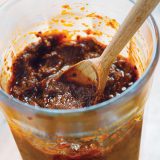Harissa started humble—a simple paste of chilies and spices—but ended up becoming the ultimate emigrant, moving from Tunisia to Morocco and on into France. Now that harissa has reached America, we wanted to develop a flavor profile well suited to the New World.
Harissa (pronounced ha-REE-sah) may well be one of the original hot sauces, and it has enjoyed a bit of piggyback popularity in the U.S. as Sriracha and other spicy condiments have attracted near cultish followings. Prior to the 1500s, chilies didn’t exist in Africa, so neither did harissa. Chilies had been eaten for thousands of years elsewhere but didn’t land in Africa until the mid-16th century via conquerors, colonialists and traders returning from Central America.
The easy-to-grow ingredient found a warm reception in arid African climates, adding an affordable kick to previously bland grain-based diets. Capsaicin—the fiery active ingredient in chilies—induces sweating and suppresses hunger, cooling and satiating all at once. So it’s no surprise that North African cuisines quickly adopted sauces built around that heat.
Tunisia is credited with the birth of harissa. From there it spread to Libya, Algeria, Morocco and eventually France, where Northwest African cuisine gained traction following the slow collapse of the French empire after World War II
In Tunisia, harissa is standard alongside couscous and brik, a tuna-and-egg turnover. Moroccans thin the paste with water or oil and serve it as a condiment for spit-roasted lamb. Modern Libyans dab it on pizza and sandwiches, but their forebears scooped it onto zumita, a paste of flour and water. And across the region it often is used as the base of sauces, including for tagines, soups and shakshuka, a poached egg dish.
Which is to say, harissa sprawled and morphed, making it difficult to get agreement on exactly what goes into it. Chilies are a given. Cumin, garlic, lemon and olive oil also show up in most variants. After that it’s murky. Mediterranean and Moroccan culinary authority Paula Wolfert published an early harissa recipe in her 1973 cookbook, “Couscous and Other Good Food from Morocco.” She called for grinding together nothing but 1 ounce of dried red chili peppers, a clove of garlic, a bit of salt and a splash of olive oil. Thirty years later, in another cookbook, she offered three Tunisian harissa recipes, variously calling for dried rosebuds, fermented onions and sun-dried tomatoes.
Rather than toast and rehydrate dried chilies, fry them in oil; it softens them and better draws out their oil-soluble flavors.
Tunisians have a stronger predilection for spice than their neighbors, so their harissa emphasizes heat. In Morocco, where flavors tend to be more nuanced, tomato paste, rose water and preserved lemon might play into the condiment’s flavor.
For our recipe, we wanted a harissa that was honest to its origins, yet suited to the foods and flavors of the American palate. There should be heat but not too much. And while traditional recipes often are fussy in the way they prep the chilies, we wanted a streamlined process.
Many harissa recipes call for a mix of chili varieties, but we found this to be a hassle at the grocer, and the subtle differences weren’t worth the trouble. We settled on New Mexico chilies, which have a balanced heat. To satisfy heat fiends, we added cayenne at the end, which allows for easy adjustments to the intensity of the finished dish.
Some combination of cumin, caraway and coriander is traditional, and we settled on cumin and caraway. The coriander added a bit too much of a citrusy flavor. Whole spices were a must; ground spices tasted dusty. And while olive oil is the classic choice, we found it too bitter, preferring a less conventional neutral oil, such as grapeseed.
We added a bit of garlic but still weren’t happy with our harissa. This is where we mixed things up a bit. Plenty of recipes call for either sun-dried tomatoes or roasted red peppers, the sweetness of which rounds out the flavor of the dried chilies. Each was fine on its own, but it wasn’t until we combined them that we got the results we wanted. Together, the tomatoes and peppers gave the harissa the sweet ketchupy profile Americans love.
Instead of individually toasting the chilies, whole spices and garlic—the traditional method—we fried everything together in oil. This was easier and more flavorful. Most recipes call for rehydrating the peppers, but we found the hot oil softened the chilies adequately, giving the harissa a pleasant, slightly coarse texture.
The result has just the right piquancy to serve as a starter harissa. Homemade harissa keeps in the refrigerator for up to three weeks and does wonders for dips, soups, sauces and vinaigrettes.




